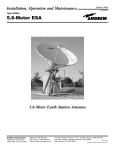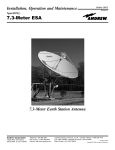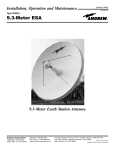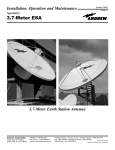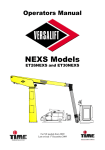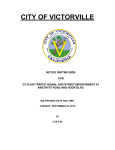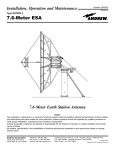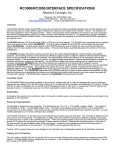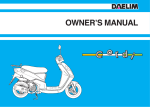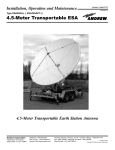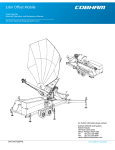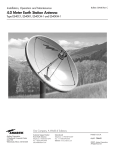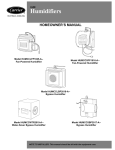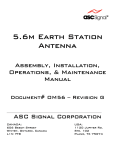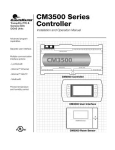Download Andrew operation and maintenance Specifications
Transcript
Installation, Operation and Maintenance Bulletin OM49 Revision G Type ES49( ) 4.9-Meter ESA 4.9-Meter Earth Station Antenna Notice The installation, maintenance, or removal of antenna systems requires qualified, experienced personnel. Andrew installation instructions have been written for such personnel. Antenna systems should be inspected by qualified personnel to verify proper installation, maintenance and condition of equipment. Andrew Corporation disclaims any liability or responsibility for the results of improper or unsafe installation and maintenance practices. All designs, specifications, and availabilities of products and services presented in this manual are subject to change without notice. Andrew Corporation 10500 West 153rd Street Orland Park, IL U.S.A. 60462 Telephone: 708-349-3300 FAX (U.S.A.): 1-800-349-5444 Internet: http://www.andrew.com Customer Service, 24 hours: U.S.A. • Canada • Mexico: 1-800-255-1479 U.K.: 0800 250055 • Republic of Ireland: 1 800 535358 12/03 Other Europe: +44 1592 782612 Copyright © 2003 by Andrew Corporation Table of Contents Introduction Introduction. . . . . . . . . . . . . . . . . . . . . . . . . . . . . . . . . . . . . . . . . . . . . . . . . . . . . . . . . . . . . . . . . . . . . . . . 3 Proprietary Data . . . . . . . . . . . . . . . . . . . . . . . . . . . . . . . . . . . . . . . . . . . . . . . . . . . . . . . . . . . . . . . . 4 Information and Assistance. . . . . . . . . . . . . . . . . . . . . . . . . . . . . . . . . . . . . . . . . . . . . . . . . . . . . . . . 4 Notice . . . . . . . . . . . . . . . . . . . . . . . . . . . . . . . . . . . . . . . . . . . . . . . . . . . . . . . . . . . . . . . . . . . . . . . . 4 Technical Assistance . . . . . . . . . . . . . . . . . . . . . . . . . . . . . . . . . . . . . . . . . . . . . . . . . . . . . . . . . . . . 4 How to Use This Manual Overview . . . . . . . . . . . . . . . . . . . . . . . . . . . . . . . . . . . . . . . . . . . . . . . . . . . . . . . . . . . . . . . . . . . . . . . . . . 5 Content . . . . . . . . . . . . . . . . . . . . . . . . . . . . . . . . . . . . . . . . . . . . . . . . . . . . . . . . . . . . . . . . . . . . . . . 5 Getting Started Overview . . . . . . . . . . . . . . . . . . . . . . . . . . . . . . . . . . . . . . . . . . . . . . . . . . . . . . . . . . . . . . . . . . . . . . . . . . 6 Warnings . . . . . . . . . . . . . . . . . . . . . . . . . . . . . . . . . . . . . . . . . . . . . . . . . . . . . . . . . . . . . . . . . . . . . . 6 Recommended Tools . . . . . . . . . . . . . . . . . . . . . . . . . . . . . . . . . . . . . . . . . . . . . . . . . . . . . . . . . . . . 7 Parts Verification . . . . . . . . . . . . . . . . . . . . . . . . . . . . . . . . . . . . . . . . . . . . . . . . . . . . . . . . . . . . . . . . 8 Reporting Equipment Loss or Damage . . . . . . . . . . . . . . . . . . . . . . . . . . . . . . . . . . . . . . . . . . . . . . 8 Reporting Visible Loss or Damage. . . . . . . . . . . . . . . . . . . . . . . . . . . . . . . . . . . . . . . . . . . . . . . . . . 8 Reporting Concealed Damage. . . . . . . . . . . . . . . . . . . . . . . . . . . . . . . . . . . . . . . . . . . . . . . . . . . . . . 8 Inventory Equipment Received . . . . . . . . . . . . . . . . . . . . . . . . . . . . . . . . . . . . . . . . . . . . . . . . . . . . 8 Returning Equipment . . . . . . . . . . . . . . . . . . . . . . . . . . . . . . . . . . . . . . . . . . . . . . . . . . . . . . . . . . . . 9 Installation Procedures Overview . . . . . . . . . . . . . . . . . . . . . . . . . . . . . . . . . . . . . . . . . . . . . . . . . . . . . . . . . . . . . . . . . . . . . . . . . . 10 Foundation Preparation . . . . . . . . . . . . . . . . . . . . . . . . . . . . . . . . . . . . . . . . . . . . . . . . . . . . . . . . . . 10 Foundation Notes . . . . . . . . . . . . . . . . . . . . . . . . . . . . . . . . . . . . . . . . . . . . . . . . . . . . . . . . . . . . . . . 12 A325 Tensioning . . . . . . . . . . . . . . . . . . . . . . . . . . . . . . . . . . . . . . . . . . . . . . . . . . . . . . . . . . . . . . . 13 Reflector/Backstructure Assembly . . . . . . . . . . . . . . . . . . . . . . . . . . . . . . . . . . . . . . . . . . . . . . . . . .14 Subreflector Support Brackets . . . . . . . . . . . . . . . . . . . . . . . . . . . . . . . . . . . . . . . . . . . . . . . . . . . . .18 Rotating Tube Assembly . . . . . . . . . . . . . . . . . . . . . . . . . . . . . . . . . . . . . . . . . . . . . . . . . . . . . . . . . 20 Polarization Drive Installation . . . . . . . . . . . . . . . . . . . . . . . . . . . . . . . . . . . . . . . . . . . . . . . . . . . . . 21 Subreflector Assembly . . . . . . . . . . . . . . . . . . . . . . . . . . . . . . . . . . . . . . . . . . . . . . . . . . . . . . . . . . . 22 Pedestal Ground Mount Assembly . . . . . . . . . . . . . . . . . . . . . . . . . . . . . . . . . . . . . . . . . . . . . . . . . .24 Pedestal Installation. . . . . . . . . . . . . . . . . . . . . . . . . . . . . . . . . . . . . . . . . . . . . . . . . . . . . . . . . . . . . 24 Reflector to Ground Mount Assembly. . . . . . . . . . . . . . . . . . . . . . . . . . . . . . . . . . . . . . . . . . . . . . . . 28 Subreflector Installation and Adjustment . . . . . . . . . . . . . . . . . . . . . . . . . . . . . . . . . . . . . . . . . . . . 30 Operation Overview . . . . . . . . . . . . . . . . . . . . . . . . . . . . . . . . . . . . . . . . . . . . . . . . . . . . . . . . . . . . . . . . . . . . . . . . . . 33 Acquiring A Satellite . . . . . . . . . . . . . . . . . . . . . . . . . . . . . . . . . . . . . . . . . . . . . . . . . . . . . . . . . . . . . 33 Subreflector Adjustment . . . . . . . . . . . . . . . . . . . . . . . . . . . . . . . . . . . . . . . . . . . . . . . . . . . . . . . . . .37 Preventive Maintenance Overview . . . . . . . . . . . . . . . . . . . . . . . . . . . . . . . . . . . . . . . . . . . . . . . . . . . . . . . . . . . . . . . . . . . . . . . . . . 38 General Cleaning . . . . . . . . . . . . . . . . . . . . . . . . . . . . . . . . . . . . . . . . . . . . . . . . . . . . . . . . . . . . . . . 38 Electrical Parts. . . . . . . . . . . . . . . . . . . . . . . . . . . . . . . . . . . . . . . . . . . . . . . . . . . . . . . . . . . . . . . . . . 38 Mechanical Parts. . . . . . . . . . . . . . . . . . . . . . . . . . . . . . . . . . . . . . . . . . . . . . . . . . . . . . . . . . . . . . . . 39 Inspection. . . . . . . . . . . . . . . . . . . . . . . . . . . . . . . . . . . . . . . . . . . . . . . . . . . . . . . . . . . . . . . . . . . . . .39 Antenna . . . . . . . . . . . . . . . . . . . . . . . . . . . . . . . . . . . . . . . . . . . . . . . . . . . . . . . . . . . . . . . . . . . . . . . 39 Preservation of Component Parts. . . . . . . . . . . . . . . . . . . . . . . . . . . . . . . . . . . . . . . . . . . . . . . . . . . 41 Aluminum Parts . . . . . . . . . . . . . . . . . . . . . . . . . . . . . . . . . . . . . . . . . . . . . . . . . . . . . . . . . . . . . . . . 41 Galvanized Surfaces . . . . . . . . . . . . . . . . . . . . . . . . . . . . . . . . . . . . . . . . . . . . . . . . . . . . . . . . . . . . . 41 Lubrication . . . . . . . . . . . . . . . . . . . . . . . . . . . . . . . . . . . . . . . . . . . . . . . . . . . . . . . . . . . . . . . . . . . . 41 2 Table of Contents 4.9-Meter Earth Station Antenna Introduction Like all Andrew earth station antennas, the 4.9-Meter Earth Station Antenna provides high gain and exceptional pattern characteristics. The electrical performance and exceptional versatility provides the ability to configure the antenna with your choice of linearlyor circularly-polarized 2-port or 4-port combining network. That versatility is provided at the time of initial purchase, as well as in the future, as your satellite communication requirements evolve. The aluminum reflector is precision formed for accuracy and strength requiring minimal assembly. The reflector assembly is 16-feet (4.9-meters) in diameter and segmented in a twelve piece configuration to reduce shipping volume and facilitate transport to remote sites. Reflector panels are conversion coated and painted with a flat white paint. The manual pedestal tube mount features 360 degree azimuth coverage in continuous 40 degree ranges and executes 90 degree (0 - 90 degree) continuous elevation adjustment. The manual mount also features ±20° of continuous fine azimuth adjustment. This large adjustment range provides the ability to view geostationary satellites from horizonto-horizon, from any location worldwide. The motorizable pedestal tube mount may be purchased which features self-aligning bearings for the elevation pivots, resulting in "zero" backlash. This mount can be operated manually, but has the ability to be upgraded for motorized operation, including steptracking/Smartrack™ applications. The motorizable mount type is indicated by the ES49MPJ letters within the antenna type number. The azimuth/elevation jackscrews are equipped for integration with the optional motor drive systems. The aluminum enclosure and hot-dipped galvanized steel mount maintain pointing accuracy and ensures durability and reliability. The antenna and standard manual mount with enclosure will survive 125 mph (200 km/h) wind, in any position of operation, without damage or permanent deformation in moderate coastal/industrial areas. Severe conditions require additional protection. Andrew provides a complete line of available options, including motor drive systems (with power interfaces addressing domestic and international standards), remote microprocessor antenna control for motor drive systems, pressurization equipment, and interconnecting HELIAX® cables and waveguide. 3 Introduction Proprietary Data The technical data contained herein is proprietary to Andrew Corporation. It is intended for use in operation and maintenance of Andrew supplied equipment. This data shall not be disclosed or duplicated in whole or in part without express written consent of Andrew Corporation. Information and Assistance Andrew Corporation provides a world-wide technical support network. Refer to the technical assistance portion of this this manual for the contact numbers appropriate to your location. Notice The installation, maintenance, or removal of antenna systems requires qualified, experienced personnel. Andrew installation instructions have been written for such personnel. Antenna systems should be inspected by qualified personnel to verify proper installation, maintenance and condition of equipment. Andrew Corporation disclaims any liability or responsibility for the results of improper or unsafe installation and maintenance practices. All designs, specifications, and availabilities of products and services presented in this manual are subject to change without notice. Copyright © 2003, Andrew Corporation Technical Assistance 24-hour Technical Assistance For technical assistance, call the following numbers at anytime. Call From Call To Telephone Fax North America (toll free) U. S. A. +(1) 800-255-1479 +(1) 800-349-5444 Any Location (International) U. S. A. +(1) 708-349-3300 +(1) 708-349-5410 Customer Service Center The Andrew Customer Service Center gives you direct access to the information and personnel service you need, such as the following: • Place or change orders • Check price and delivery information • Request technical literature You can call from any of the following: Call From Telephone Fax North America +(1) 800-255-1479 (toll free) +(1) 800-349-5444 (toll free) United Kingdom 0800-250055 (toll free) 44-118-9366-777 Australia 1-800-803-219 (toll free) 61-3-93579110 China 00-800-0-255-1479 00-800-0-349-5444 New Zealand 0800-441-747 (toll free) 61-3-3579110 Hong Kong 001-800-0-255-1479 002-800-0-349-5444 4 Introduction How to Use This Manual Overview The scope of this manual is intended to provide station personnel with the base installation, operation, and maintenance requirements necessary for a 4.9-Meter C-, X-, Ku- or K-band Earth Station Antenna. This manual provides a convenient reference for authorized operator/service personnel requiring technical information on general system or specific subsystem equipment. The tables and figures presented in this manual are used as communication aids for the installation, operation, and maintenance of the 4.9-Meter Earth Station Antenna. These tables and figures instantly convey messages, as well as make the procedures easier to understand. This manual uses tables and figures for the following references: • Tables The tables allow you to locate information quickly and easily. • Drawings The drawings supplement the installation instructions by using a combination of graphics and verbage to assist you in simplifying complex procedures and clarifying components. • Photographs The photographs compliment the installation instructions by providing actual examples of the steps being performed, which allow you to view the installation progress in the proper sequence. Content The manual is divided into five distinct sections, each dealing with a specific technical topic relating to either system or component subsystem information. The sections contained in this manual are described and listed under the following technical headings: • How to Use Describes the manual's purpose, content, and communication aids. This Manual Additionally, this section lists the related documentation for the 4.9Meter Earth Station Antenna. • Getting Started • Installation Procedures • Operation Provides the preliminary information needed to perform a successful installation. This section should be reviewed prior to the installation. The warnings, recommended tools, parts verification, instructions on reporting lost or damaged equipment, and installation checklist are located in this section. Provides the procedures for the different phases of a 4.9-Meter Earth Station Antenna base installation. This section will help you easily find requirements for an individual task, as well as displays the sequence for each task execution. Describes the controls, functions, and general operating procedures required for proper operation of the 4.9-Meter Andrew Earth Station Antenna. • Preventive Describes preventive maintenance procedures that are required to Maintenance maintain proper functional operation of your new Andrew Earth Station Antenna. 5 How to Use This Manual Getting Started Overview The installation, operation, and maintenance of the 4.9-Meter Earth Station Antenna requires qualified and experienced personnel. Andrew installation, operation, and maintenance instructions are illustrated for such personnel. Additionally, the antenna should be inspected by qualified personnel to verify proper installation, maintenance, and condition of equipment as described in Preventive Maintenance. The basic equipment and accessories are either manufactured or design controlled by Andrew Corporation. The prerequisite information necessary for the 4.9-Meter Earth Station Antenna can be found in this section. Furthermore, this section should be reviewed BEFORE performing the installation, operation, or maintenance. Recommended warnings, recommended tools, and the antenna parts can be verified and/or determined with such a review. Warnings When installing the 4.9-Meter Earth Station Antenna, be conscious of the recommended warnings presented below. For further information or clarification of this information, contact the Customer Service Center. The recommended warnings are as follows: 1. Electrical shock from voltages used in this antenna system may cause personal injury or death. Prior to making any electrical connections or performing maintenance or repair, ensure that the power is removed. Electrical connections should be made only by qualified personnel in accordance with local regulations. 2. Installation of antennas may require persons to work at elevated work stations. Whenever persons are working at eight or more feet above the ground and not on a guarded platform, they should wear safety belts with at least one (preferably two) lanyards. 3. Never stand underneath any object while it is being lifted. 4. Always wear a hard hat, especially if someone is above you. 5. Make sure no person is in or under the reflector while it is being lifted or positioned; personal injury can result if the reflector assembly falls. 6. Personnel should never be hoisted in or out of the reflector by the crane; personal injury may result. 7. Andrew earth station antennas supplied to standard product specifications will survive 125 mph winds in any operational position in moderate coastal/industrial areas. Severe conditions require additional protection. Should it be expected that winds will exceed 125 mph, it is recommended that Andrew antennas be steered to specific azimuth and elevation orientations (refer to #8) to minimize wind forces upon the structure and thereby increase the probability of survival. 8. It is recommended that all cross-axis waveguide and coaxial cables are secure such that high winds will not cause excessive flexing. Position the antenna to an elevation of 90 degrees. The azimuth jackscrew should be placed in the center of its travel. 9. When the antenna is transmitting, severe eye injury or injury to other parts of the body can result from exposure to radio frequency (RF) energy. The antenna must be turned off before entering the area in front of the reflector and near the feed. 6 Getting Started NOTE: Failure to follow an installation procedure could result in damage to equipment or personal injury. Additional warnings will be displayed throughout this manual for your awareness. These warnings can be identified in warning boxes as shown in the following sample. Andrew disclaims any liability or responsibility for the results of improper or unsafe installation, operation, or maintenance practices. Recommended Tools Andrew supplies all appropriate hardware/parts required for the installation of your 4.9Meter Earth Station Antenna. All tools necessary for the installation process should be provided by the installation crew. Andrew recommends the following tools to be used for a proper installation of the 4.9-Meter Earth Station Antenna. Tool Size Open End or Combination Wrenches Pipe Wrench Spud Wrench Crane Nylon Choker (3/8” dia) Nylon Choker (3/8” dia) Choker (1/2” dia) Shackles Puller Hoist Drive Sockets (1/2”) Drive Ratchet Drive Extension Screw Driver Portable Electric Drill Adjustable Wrench Allen Wrench Tag Line Step Ladder Extension Ladder Felt-tip Marker (or other marking device) Hammer Tape Measure Rubber Mallet Pry Bar Tin Snips Temporary Wood Support Lumber Temporary Wood Support Blocks Safety Gloves (each installer) Electronic Digital Level or Equivalent 7/16 Inch 1/2 Inch 9/16 Inch 3/4 Inch 7/8 Inch 1-1/16 Inch 1-1/8 Inch 1-3/16 Inch 1-1/4 Inch 1-5/16 Inch 1-3/8 Inch 1-7/16 Inch 1-1/2 Inch 1-5/8 Inch 1-9/16 Inch 3-3/16 Inch 3 Inch Opening 1-1/4 Inch 15 Ton 6 Foot 3 Foot 16 Foot 5/8 Inch 1 Ton 7/16 Inch 1/2 Inch 9/16 Inch 3/4 Inch 7/8 Inch 1-1/16 Inch 1-1/4 Inch 1-1/2 Inch 1/2 Inch 1/2 Inch Slotted and Phillips 8 Inch 5/16 Inch 3/16 Inch 1/4 Inch 5/32 Inch 7/64 Inch 20 Foot 12 Foot 25 Foot Standard Standard 25 Foot Standard Standard Standard 2 x 4 x 8 Foot Standard Quantity 2 2 2 2 2 2 2 2 2 2 2 2 2 2 1 1 1 1 1 2 2 4 4 1 2 2 2 2 2 2 2 2 2 2 2 1 1 4 4 4 4 4 4 2 2 1 1 1 1 1 1 4 4 1 1 Table 2-1. Recommended Tools 7 Getting Started Parts Verification Reporting Equipment Loss or Damage Reporting Visible Loss or Damage Andrew Corporation thoroughly inspects and carefully packs all equipment before shipment. If you find that there are missing components, please notify Andrew Corporation immediately by contacting the Customer Service Center (refer to page 4). If you find that there was damage caused to the equipment during the shipping process, a claim should be filed with the carrier. Follow the "Reporting Visible Loss or Damage" or "Reporting Concealed Damage" procedures when filing a claim with the carrier. Make a note of any loss or evidence of external damage on the freight bill or receipt, and have it signed by the carrier's agent. Failure to adequately describe such external evidence of loss or damage may result in the carrier refusing to honor a damage claim. The form required to file such a claim will be supplied by the carrier. Reporting Concealed Damage Concealed damage means damage which does not become apparent until the unit has been unpacked. The contents may be damaged in transit due to rough handling, even though the carton may not show external damage. If you discover damage after unpacking the unit, make a written request for an inspection by the carrier's agent, then file a claim with the carrier since such damage is most likely the carrier's responsibility. Inventory Equipment Received After opening your shipment, an inventory of the parts should occur immediately. Check each item received in your shipment against the packing slip included with the shipment. If any items are missing, please refer to page 9 for step-by-step instructions on how to properly report the equipment loss. 8 Getting Started Returning Equipment Andrew Corporation tries to ensure that all items arrive safe and in working order. Occasionally, despite these efforts, equipment is received which is not in working condition. When this occurs, and it is necessary to return the equipment to Andrew Corporation for either repair or replacement, return can be expedited by following the procedure listed below: Step 1 Call the Andrew Customer Service Center and request a Return Material Authorization (RMA) number, as well as an address to forward the material. Step 2 Tag or identify the defective equipment, noting the defect or circumstances. Also, be sure to write the RMA number on the tag. It would be helpful to reference the sales order and purchase order, as well as the date the equipment was received. Step 3 Pack the equipment in its original container with protective packing material. If the original container and packing material are no longer available; pack the equipment in a sturdy corrugated box, and cushion it with appropriate packing material. Step 4 Be sure to include the following information when returning the equipment: • Your Company Name • Your Company Address • City, State, and Zip Code • Telephone Number • RMA Number • Problem Description • Contact Name NOTE: Absence of the RMA number will cause a delay in processing your equipment for repair. Be sure to include the RMA number on all correspondence. Step 5 Ship the equipment to Andrew Corporation using UPS, U.S. Postal Service, or other appropriate carrier; freight prepaid and insured. The material should be forwarded to the address given by the Andrew contact in Step 1. 9 Getting Started Installation Procedures Overview Foundation Preparation This section provides installation procedures for the 4.9-Meter Andrew Earth Station Antenna. The installation procedures include instructions on the following antenna components: • Reflector/Enclosure • Reflector-to-Mount Assembly • Mount • Subreflector Before beginning the installation process on the ground mount assembly, ensure that the foundation has been prepared. Foundation specifications are provided by Andrew and may be used as a reference by civil engineering personnel when preparing the foundation for local soil conditions. These specifications are available before the shipment arrives by contacting the Customer Service Center or your Account Manager. • Foundation should be dimensioned as detailed in Figures 1a and 1b. • Sweep foundation clear of any dirt or debris. • To ensure smooth surface for mount, scrape foundation pad. • Studs should extend 6 in. above the surface and are 1.25 in. in diameter • Apply stick wax to stud threads to ease later connections. Figure 1a 10 Installation Procedures Foundation Preparation Figure 1b 11 Installation Procedures Foundation Notes 1. Remove all burrs and sharp edges. 2. Dimensions apply before plating. 3. Interpret drawing per ANSI Y14.5M-1982. 4. Dimensions are shown in feet and inches. Dimensions in brackets [ ] are in millimeters. 5. A tolerance of ±1/8" [3] applies to all anchor bolt layout dimensions. 6. Foundation Notes: A) This foundation is a typical design only. Certification of it's suitability for a particular installation by a professional engineer is required prior to it's use for actual fabrication. B) Contractor shall field verify all dimensions locating existing construction before fabrication of new construction begins. C) Concrete and related work shall be mixed, placed and cured in accordance with "Building Code Requirements for Reinforced Concrete" ACI 318-89 (Rev. 88) and "Specifications for Structural Concrete" ACI 301-84 (Rev. 88) publication SP-15 (88). D) Concrete for foundations shall develop a compressive strength of at least 3000 psi [211 kgf/cm2] in 28 days with a maximum slump of 3" [76] at time of placing. E) Reinforcing bars shall conform to ASTM A 615 [S1] grade 60 deformed type Fy = 60000 psi [4219 kgf/cm2]. F) Unless otherwise noted, concrete cover of reinforcing bars shall conform to minimum requirements of ACI 318-89 (Rev. 88). G) Fabrication of reinforcing steel shall be in accordance with "Manual of Standard Practice for Detailing Reinforcing ConcreteStructures" ACI 315-80 (Rev. 86). H) Provide 3/4" x 45° [19 x 45°] chamfer on all exposed concrete edges. J) Foundations have been designed to rest on undisturbed soil (per EIA-411-A and RS-222-D) with a minimum allowable net vertical bearing capacity of 2000 psf [9770 kgf/m2]. If undesirable soil conditions are encountered, the engineer shall be notified. K) Backfills shall be suitable excavated material or other suitable material compacted in 6" lifts to 90% of maximum density as determined by ASTM D1557. L) If this foundation is to be located in an area where annual frost penetration depth exceeds 15" [381], the local building code specifying a minimum required foundation depth should be consulted. 7. Grounding Electrode System Notes: The grounding system shown represents the minimum requirements to achieve satisfactory grounding. Actual site conditions and soil resistivity levels will determine final grounding system design to comply with the following: A) All ground ring, ground rod and antenna structure connections to be EIRCO® products, Inc. Calweld® exothermic type welded electrical connections or equivalent. B) Ground rods shall be driven to a depth below permanent moisture level (minimum depth shown) as dictated by geographical location. C) The antenna structure shall be connected to a grounding electrode system consisting of a number of interconnected ground rods. The system shall meet the requirements of the Underwriters' Laboratories Publication No. ,UL96A for Lightning protection. D) The grounding electrode system to earth resistance shall not exceed 10 Ohms, measured with a Biddle 3 terminal device or equivalent. The grounded conductor (neutral) supplied to all ac equipment on the antenna structure should be disconnected before taking measurement. E) Actual site conditions may require longer ground rods, additional ground rods and/or land fill additives to reduce soil resistivity levels. F) Avoid sharp bends when routing grounding wire. Grounding wires to antenna structure to be run as short and straight as possible. G) Final grade directly above grounding electrode system to be water permeable. 8. Power/IFL Conduit Notes: A) Electrical power - Drawing depicts suggested location for electrical power conduit to antenna. Size, type and depth to bury conduit to be determined by customer in compliance with local codes. Direction to route conduit to be determined by the relative location of communcations building/shelter. Power conduit to extend 6" (minimum) above surface of foundation slab. Open ends of conduit to be sealed to prevent moisture and foreign particle contamination. Customer to provide main load center assembly and over-current protection devices for electrical equipment. Mounting location of load center to be determined by customer in accordance with local codes. B) For routing IFL cables, 4” size conduit recommended. Type and depth to bury conduit to be determined by customer, in compliance with local codes. Location of conduit on foundation and direction to route conduit to be determined by location of communications building/shelter. Conduit to extend 36” (minimum) above surface of foundation slab. All bends to be large radius, maximum of two bends per run. Open ends of conduit to be sealed to prevent moisture and/or foreign particle contamination. 12 Installation Procedures A325 Tensioning During the installation process, there are several references to the A325 hardware tensioning procedure. The A325 hardware must be properly tensioned to avoid slippage between bolted surfaces under high loads. Slippage can cause the corresponding assembly to move, causing antenna misalignment. When designated, the A325 hardware should be tightened according to the following tensioning procedure. NOTE: Tensioned bolts are for final connections only and should not be loosened for reuse. Step 1 Lubricate the bolt threads with the provided stick wax to reduce friction. Step 2 Insert the bolt, and add a flat washer—if required. Do not allow wax under the flat washer. Step 3 Add the nut, and finger tighten. Step 4 After the connections are complete, tighten the bolts until the surfaces are joined and the nuts are snug (for example, full effort of a person using an ordinary spud wrench). Do not proceed with Steps 5 and 6, unless the connection is final and is not intended to be loosened again. Note: If the bolts are loosened after Steps 5 and 6, discard and replace with new hardware. Step 5 Using a felt-tip marker, mark the nuts and the ends of the bolts with a straight line as shown in Figure 2-1a and Figure 2-1b. Step 6 Tighten the nuts further with an extra long wrench until the nuts are moved 1/3 turn (120 degrees) as shown in Figure 3-1a for bolt lengths less than four diameters and 1/2 turn (180 degrees) as shown in Figure 3-1b for bolt lengths over four diameters. Use Felt Marker Before Tensioning After Tensioning Use Felt Marker Before Tensioning After Tensioning Figure 2-1a: A325 Tensioning ProcedureFigure 2-1b: A325 Tensioning For bolts less than 4 diameters For bolts over four diameters 13 Installation Procedures Reflector/Back Structure Assembly Use of A325 hardware eliminates slippage between mating surfaces under high loading conditions as well as the need for future retightening. Refer to the A325 tensioning procedure in preceding installation text. CAUTION: Adhere to any special instructions stenciled on crate relative to crate opening, contents removal and/or personnel safety. Note: Install reflector/back structure assembly only when winds are less than 15 mph to prevent damage to reflector panels and ease overall assembly. Step 1 Position 302649 Hub Assembly on 4 temporary wood support blocks and attach 302648 Short Struts to the Hub Assembly as shown in Figure 3. Note: Securely tighten all stainless shoulder bolts followed by any A325 hardware following the A325 Hardware tensioning procedure mentioned previously. Reference Drawing 240270 Top View 302648 Short Strut Short Strut Extends Above Top of Antenna Hub Round Feed Hole Faces Upward 3/8” Lock Washer (9974-63) 3/8” Hex Nut (9999-60) 3/8” ID x 7/8” OD Flat Washer (9997-145) 1/2” ID x 1/2” x 1-1/4” 1” OD Shoulder Flat Bolt Washer (9858-39) (9997-65) 18” to 24” 1/2” ID x 1/2” 1/2” ID x 1/2” x 2-1/2” 1” OD Hex Head Lock 1” OD Flat Capscrew Washer Flat Washer (9963-137) (9974-64) Washer 1/2” ID x (9997-65) (9997-65) 1/2” x 2-1/2” 1” OD 302649 Hex Head Flat Hub Assembly Capscrew Washer (9997-65) (9963-137) Top of Hub Assembly Rib #2 Rib #11 1/2” Hex Nut (9999-61) 1/2” ID x 1/2” 1” OD 1/2” Lock Flat Hex Nut Washer Washer (9999-61) (9974-64) (9997-65) Rib #1 Rib #12 Rib #10 Rib #3 3/8” Hex Nut (9999-60) 3/8” Lock Washer (9974-63) 3/8” ID x 7/8” OD Flat Washer (9997-145) 302649 Hub Assembly 1/2” ID x 1/2” x 1-1/4” 1” OD Shoulder Flat Bolt Washer (9858-39) (9997-65) 302648 Short Strut Rib #9 Rib #4 Rib #6 Rib #7 Rib #8 Rib #5 Rear View of Hub Figure 3 14 Installation Procedures Step 2 Loosely attach 302511 Ribs to 302648 Short Struts as shown in Figure 4. Note: Do not fully tighten hardware at this time. Support end of rib until 302509 Long Strut is installed. 1/2” 1/2” ID 1” Lock OD Washer Flat (9974-64) Washer 1/2” (9997-65) Hex Nut (9999-61) 302511 Rib 5/8” x 1/2” Shoulder Bolt (9858-36) 302648 Short Strut Note: Temporarily Support Rib Until 302509 Long Strut is Installed Reference Drawing 240272 Figure 4 Step 3 Loosely attach 302509 Long Struts to 302648 Short Struts and 302511 Ribs as shown in Figures 5a and 5b. Do not fully tighten hardware at this time. Note: Observe placement of 209765-1 1/4” Spacer between the long and short struts. Reference Drawing 240272 302509 Long Strut 302648 Short Strut 5/8” x 3/4” Shoulder Bolt (9858-31) 1/4” Spacer (209765-1) 1/2” ID 1” 1/2” 1/2” OD Hex Nut Lock Flat Washer Washer (9999-61) (9997-65) (9974-64) Figure 5a 15 Installation Procedures 1/2” ID x 5/8” ID x 1” OD 1/2” 1-5/16” OD Flat Lock Flat Washer Washer Washer (9997-65) (9974-64) (9997-236) 1/2” Hex Nut (9999-61) 302511 Rib Reference Drawing 240272 5/8” ID x 1-5/16” OD Flat Washer 5/8” x 1/2” (9997-236) Shoulder Bolt (9858-36) 5/8” x 1-3/4” Bolt and Nut Assembly (45980-14) 5/8” x 1-3/4” Bolt and Nut Assembly (45980-14) 5/8” ID x 1-5/16” OD Flat Washer (9997-227) 302509 Long Strut Step 4 Step 5 Figure 5b When all 12 rib/strut sets have been loosely assembled, securely tighten all stainless steel shoulder bolts first, next, tighten all A325 hardware following previously mentioned tensioning procedure. Attach 302512 Skirts to outer edge of each 302510 Reflector Panel as shown in Figure 6. Ensure the edge angle of the skirt is in the same direction as the edge angle of the panel. Securely tighten all hardware. Note: All 302512 Skirts are to be installed before the 302510 reflector panels are installed on the ribs. Reference Drawing 240272 1/4-20 x 1-1/4” Socket Head Capscrew (45055-2) 302510 Reflector Panel 1/4” Lock Washer (9974-15) 1/4” Hex Nut (9999-57) 302512 Skirt Figure 6 16 Installation Procedures Step 6 Attach the reflector panels (with skirts) by placing them on the ribs and sliding them inward carefully guiding them until the rib and panel holes align. Place the seam hardware in the fourth hole from the outboard edge on both sides of the panel to set panel bay spacing, finger tighten only. Install remaining reflector panel hardware, finger tight only. Note: Panels should be installed opposite each other to ensure proper balancing of the enclosure assembly. Panel 1, Panel 7, Panel 4, Panel 10, etc. as shown in Figure 7. All panels are interchangeable except panels 1, 2 and 12 due to Logo positioning. Do not install panel 6 or tighten any panel hardware at this time. Note: All reflector panel hardware is 1/4-20 x 1-1/4” Socket Head Capscrews (45055-2), 1/4” Lock Washers (9974-15) and 1/4” Hex Nuts (9999-57). Note: All panels are interchangeable except panels 1, 2 and 12. Note: Do not install panel six at this time to allow easier access to reflector center for future component installation. Reference Drawing 240272 Figure 7 17 Installation Procedures Subreflector Support Brackets Step 1 Attach four 206278 lifting tabs across the second and third pairs of reflector seam holes from reflector center as shown in Figure 8. Note: Do not fully tighten lifting tab hardware at this time. Reference Drawing 240272 Note: To be removed after reflector installation on ground mount. 206278 Lifting Tab 1/4 x 1-1/4” Socket Head Capscrew (45055-2) 1/4” Lock Washer (9974-15) 1/4” Hex Nut (9999-57) Figure 8 18 Installation Procedures Step 2 Attach the four 302518 Subreflector Support Brackets at the 15th (outer most) reflector panel hole position from reflector center on ribs 2, 5, 8, and 11 as shown in Figure 9. Note: Do not fully tighten subreflector support bracket hardware at this time. 1/4 x 1-1/4” Socket Head Capscrew (45055-2) Panel 302518 Subreflector Strut Support Bracket 1/4” Lock Washer (9974-15) 1/4” Hex Nut (9999-57) Reference Drawing 240272 Figure 9 Step 3 Check reflector panels to ensure seam widths are even and panels are not overlapped or interfering with each other. If needed gently rock the reflector back and forth to help even the panel seam gaps. 19 Installation Procedures Rotating Tube Assembly Note: Applicable feed installation drawings are included with each feed system. Step 1 Install 302356 Rotating Tube Assembly as shown in Figure 10. Ensure 302507 Support Struts attach to ribs 2, 5, 8 and 11 as shown. Note: Ensure all support struts are attached to same side of reflector rib and rotating tube mounting tab. Fully tighten mounting hardware except for 3 bolts that attach polarization drive as shown in Figure 11. Step 2 Upon completion of the installation of the feed rotating tube assembly, install reflector panel #6 as described in Step 6 on page 17. Step 3 Tighten reflector panel seam hardware in concentric circles in a clockwise direction beginning with inner hardware and progressively working outward. Reference Drawing 240272 302356 Rotating Tube Assembly 302507 Rotating Tube Support Strut 3/8” Lock Washer (9974-63) Rib or Rotating Tube 302507 Rotating Tube Support Strut 302356 Rotating Tube Assembly 302649 Hub 3/8” Hex Nut (9999-60) 3/8” Flat Washer (9997-145) 302507 Rotating Tube Support Strut 1/2” ID x 1” OD Flat Washer (9997-65) 1/2 x 1/2” Shoulder Bolt (9858-19) Install Reflector Panel 6 3/8 x 1-3/4” Bolt (9963-146), Flat Washer (9997-146), Lock Washer (9974-63) and Nut (9999-60) 302511 Rib Figure 10 20 Installation Procedures Polarization Drive Installation Step 1 Attach the Polarization Drive Assembly as shown in Figure 11. Measure and cut chain to proper length. Step 2 Attach chain to coupling link on each end with supplied connecting link. Step 3 Pull pillow blocks and sprocket assembly back until chain is tight. Tighten bolts holding pillow blocks in place. Note: If a motorized polarization drive or LNA support kit is to be installed, ensure these installations are complete before installing the combiner. Note: When installing the feed combiner, rotate the feed tube all the way in either direction. The polarization orientation can be better determined while in this position. Pillow Blocks 1/4 x 3/4” Socket Head Screw (9972-6), .19 x 1.25” Socket Head Screw (9972-59) and #10 Lock Washer (9974-68) #6-32 UNC x 1/2” (9972-46) and #6 Lock Washer (9974-67) 302346 Tube Rotation Stop 302342 Coupling Link 302374 Chain Connecting Link 3/8 x 3/4” Socket Head Bolt (9972-87) Chain 302365 Manual Polarization Drive Assembly Rear View Figure 11 21 Installation Procedures Subreflector Assembly Step 1 302769 Apex Angle Bracket Loosely attach four 302767 Subreflector Struts together with the four 302769 Apex Angle Brackets as shown in Figure 12. Note: The struts are not connected to the reflector at this time. 3/8” Flat Washer (9997-145) 3/8 x 2-1/4” Hex Head Capscrew (9963-127) Reference Drawing 240272 302767 Subreflector Strut 3/8” Flat Washer (9997-145) 3/8” Lock Washer (9974-63) 3/8” Hex Nut (9999-60) Figure 12 Step 2 Loosely attach 302768 Subreflector Ring Support Brackets to the Subreflector Struts as shown in Figure 13. Note: Observe bracket positioning on the strut and ensure all brackets are orientated in the same manner. 3/8 x 2-1/4” Hex Head Capscrew (9963-127) Reference Drawing 240272 3/8” Flat Washer (9997-145) 3/8” Flat Washer (9997-145) 3/8” Lock Washer (9974-63) 302768 Subreflector Ring Support Bracket 3/8” Hex Nut (9999-60) Figure 13 22 Installation Procedures Step 3 Install 302514 Subreflector Assembly to the 302768 Subreflector Ring Support Brackets as shown in Figure 14. Securely tighten all subreflector assembly hardware at this time. Reference Drawing 240272 3/8 x 1” Hex Head Capscrew (9963-115) 3/8” Flat Washer (9997-145) 203039 Oversize Washer 3/8” Lock Washer (9974-63) 3/8” Hex Nut (9999-60) Centered Adjustment Stud Positioned Toward Top of Reflector 302514 Subreflector Assembly 302514 Subreflector Assembly 302768 Subreflector Ring Support Bracket Figure 14 23 Installation Procedures Pedestal Ground Mount Assembly Pedestal Installation The pedestal mount is an elevation-over-azimuth mount optimized for geostationary satellite applications. The mount enables continuous elevation adjustment from 0 to 90°. The azimuth axis has 360° of travel with 40° (±20°) of continuous travel at each adjustment position. The azimuth lug can be positioned every 30° around the pedestal tube. Follow the subsequent procedures for proper installation of pedestal ground mount assembly. Step 1 All ground mount hardware is type A325. Lubricate all A325 bolt threads with supplied stick wax. Note: Do not tighten hardware until ground mount installation is complete unless otherwise instructed. Step 2 Place leveling nuts and washers on foundation anchor bolts as shown in Figure 15. Reference Drawing 240287 202142 Anchor Bolts Leveling Nuts (9999-182) and Washers (9997-229) Foundation Figure 15 24 Installation Procedures Step 3 Refer to Figure 16. Using the 6 foot nylon choker under the stinger arm, and the 3 foot choker around the elevation pivot tube, lower the pedestal into position over the anchor bolts. Note: Hex nuts and flatwashers supplied with 302689 anchor bolt kit. Reference Drawing 240299 3 Ft. Choker TOP VIEW 6 Ft. Choker 3 Ft. Choker 6 Ft. Choker 3 Ft. Choker Reference Drawing 240349 6 Ft. Choker 3 Ft. Choker Pedestal Assembly (302677) Note: Jacks are not installed until after the pedestal is securely attached to the foundation. Manual Mount Shown To Foundation Pad Pedestal Assembly (303158) Motorized Mount Shown To Foundation Pad Figure 16 25 Installation Procedures Step 4 Level the pedestal plumb within ±0.5° using the leveling nuts provided. Step 5 Secure pedestal with washer and nuts as shown in Figure 17. Level Pedestal Plumb Within ±0.5° Hex Nut (9999-182) Flat Washer (9997-229) Optional: Fill Cavity With Non-Shrinking Grout 302677 Pedestal Assembly Split PVC Drain Required if Cavity is Grouted Anchor Bolts, Nuts and Washers (Part of Andrew 302689) Foundation Reference Drawing 240299 Figure 17 (Manual Mount) Note: Jacks are not installed until after the pedestal is securely attached to the foundation. Level Pedestal Plumb Within ±0.5° Optional: Fill Cavity With Non-Shrinking Grout 208366 Az/El Jack Assembly 303158 Pedestal Assembly Split PVC Drain Required if Cavity is Grouted Anchor Bolts, Nuts and Washers (Part of Andrew 302689) Foundation Reference Drawing 240349 Figure 17A (Motorized Mount) 26 Installation Procedures Step 6 (Motorized Mount Only) Refer to Figure 17B. Attach Az/El Jack Screw Assemblies and pedestal jack arm to pedestal assembly as shown. Reference Drawing 240349 9997-202 Flatwasher 45980-28 3/4” x 2.5” Lg Bolt/Nut Assembly 45980-43 1” x 3-1/2” Lg Bolt/Nut Assembly and (2) 9997-180 Flatwashers (4 Places) 45980-29 5/8” x 3-1/2” Lg Bolt/Nut Assembly and (2) 9997-227 Flatwashers (8 Places) 45980-28 3/4” x 2-1/2” Lg Bolt/Nut Assembly and (2) 9997-202 Flatwashers (4 Places) 208366 Az/El Jack Assembly 9963-476 3/8” Screw, 9997-79 3/8 Flatwasher and 9974-63 3/8” Lockwasher 45980-28 3/4” x 2-1/2” Lg Bolt/Nut Assembly and (2) 9997-202 Flatwashers (4 Places) 303155 Azimuth Jack Screw 303158 Pedestal Assembly 302169 El Jack Pin 45980-43 1” x 3-1/2” Lg Bolt/Nut Assembly and (2) 9997-180 Flatwashers (4 Places) 45980-29 5/8” x 3-1/2” Lg Bolt/Nut Assembly (8 Places) 9997-227 5/8” Flatwasher (16 Places) 303107 Pedestal Jack Arm 303143 Az Jack Arm Spacer 303108-1 Az Arm Spacer (Long) 303107 Pedestal Jack Arm 303155 Azimuth Jack Screw 9997-79 3/8” Flatwasher 9963-476 3/8” Screw, 9997-79 3/8 Flatwasher and 9974-63 3/8” Lockwasher 302169 Jack Pin 9963-476 3/8” Screw 9974-63 3/8” Lockwasher 303108-2 Az Arm Spacer (Short) 302169 Jack Pin 9997-197 1-1/2” Flatwasher 303107 Pedestal Jack Arm 303107 Pedestal Jack Arm Figure 17B 27 Installation Procedures The ground mount assembly is now completed with the necessary essentials. All ground mount options have separate instructional bulletins located in the parts kit that contain the option. Reflector to Ground Mount Assembly Step 1 The next step in the installation process is the reflector assembly. Proceed to the next step to begin installation of the reflector. Using 5/8” shackles, attach four 16 foot chokers provided to reflector lifting lugs. Lift reflector as shown in Figure 18. Reference Drawing 240299 16 Ft Choker (4 Straps) 206278 Lifting Tab Tag Lines Figure 18 28 Installation Procedures Step 2 Gently lower the reflector assembly into position and attach to elevation pivot lugs using 3/4” hardware as shown in Figure 19. Note: Refer to A325 Tensioning Procedure on page 13. • Use indicated hardware and securely tighten. Note: After attaching the reflector, the crane may now be removed while the antenna is in the zenith position. Reference Drawing 240299 45980-25 3/4” x 2-1/4” Lg Bolt/Nut Assembly Top of Hub Assembly 9997-202 Flatwasher 3/4 x 2-1/4” A325 Bolt and Nut Assembly (45980-25) 3/4” Galvanized Flat Washer (9997-202) 303882, Spacer Bar 3/4 x 2-1/4” A325 Bolt and Nut Assembly (45980-25) 9997-202 Flatwasher 302677 Pedestal Assembly Figure 19 (Manual Mount) 45980-25 3/4” x 2-1/4” Lg Bolt/Nut Assembly Both Sides 9997-227 5/8” Flatwasher (4 Places) 9997-202 Flatwasher 45980-31 5/8” x 4” Lg Bolt/Nut Assembly (2 Places) 302508 Antenna Pack 208366 Az/El Jack Assembly 303882, Spacer Bar 303158 Pedestal Assembly 9997-202 Flatwasher Reference Drawing 240349 Figure 19A (Motorized Mount) 29 Installation Procedures Subreflector Installation and Adjustment Step 1 IMPORTANT Failure to conform to the following alignment procedures may result in non-compliance to antenna performance specification. Carefully raise the completed subreflector assembly into place with the reflector in the zenith position. Attach the subreflector assembly to the reflector as shown in Figure 20. Note: All INTELSAT Type Approved antennas do not require further subreflector adjustment after performing Steps 2 thru 8. All Type Approved antennas are required to have the subreflector mechanically set per the instructions on page 30 and Figure 21 of this manual. 3/8” Hex Nut (9999-60) 302767 Subreflector Strut 3/8” Lock Washer (9974-63) Reference Drawing 240272 3/8” Flat Washer (9997-145) 3/8 x 2-1/4” Hex Head Capscrew (9963-127) 302518 Subreflector Strut Support Bracket 3/8” Flat Washer (9997-145) Figure 20 30 Installation Procedures Step 2 Reference the appropriate feed installation drawing and install the feed system assembly. Note: The feed installation instructions are packaged as part of the feed system kit. Step 3 Adjust the height of the subreflector with the 302752-( ) Subreflector Setting Rod. Rest the square end of the setting rod on top of the first panel seam screw. Choose a screw which is nearest one of the subreflector adjustment threaded rods. Refer to Figure 22 for threaded rod adjustment locations. Sweep the setting rod back and forth across the edge of the subreflector to find the shortest distance. Adjust the height of the subreflector to within 1/32” (1 mm) of the setting rod. Step 4 Center the subreflector using dimension “A”. Refer to Figure 22 for subreflector centering adjustment hardware location. Note: Dimension “A” should be taken from the edge of the feed horn to the subreflector edge. Perform this measurement at 4 locations (Top, Bottom, Left and Right). Step 5 Sweep tape measure back and forth across the subreflector edge using the shortest distance as dimension “A”. Note: Dimension “A” should not vary more than 1/16” (1.5 mm) at each of the four measurement positions. Reference Drawing 240272 Rest the Setting Rod on Top of First Seam Screw “A” 302752 Subreflector Setting Rod Feed Horn Assembly Setting Rod Types 70-3/4” Ku-Band Setting Rod Screw On Aluminum Tip 71” C-Band Setting Rod Figure 21 31 Installation Procedures Reference Drawing 240272 Subreflector Centering Adjustment Hardware (3 Places) Threaded Rod Adjustment Location (3 Places) Figure 22 Step 6 Recheck subreflector centering and height settings. Step 7 Remove and store 206278 lifting tabs. Replace panel seam hardware at lifting tab locations. Step 8 Final Subreflector Settings should be performed with antenna either in operating position or a nominal 30° elevation angle. After you have completed the assembly of your antenna, you are now ready to become operational. In order to operate the earth station antenna, you will need to direct it to the desired satellite adjusting both the elevation and azimuth angles appropriately. The following procedures provide details on how to correctly position your antenna on the desired satellite. 32 Installation Procedures Operation Overview There are several procedures that may be used to properly acquire the satellite. Andrew recommends that a spectrum analyzer be used. The following procedures provide explanation as to how to use the spectrum analyzer. Acquiring A Satellite While viewing the spectrum analyzer screen, a signal as shown in Figure 4-1 will probably be observed. Additionally, some transponder signals may be observed above the noise signal as shown. Figure 4-1: Minimum transponder Signal on Spectrum Analyzer 33 Operation The following steps provide the procedure for acquiring a satellite. Step 1 Begin by obtaining the correct Az/El pointing data for the satellite of interest based on specific calculations for this particular site. Step 2 Using an inclinometer placed on the enclosure drum surface, position the antenna to the specified elevation angle. Step 3 Manually move the antenna in the azimuth (scanning back-and-forth around the direction of the specified azimuth angle) to achieve the maximum (greatest amplitude) transponder signals. • Scan in one direction until the amplitude continues to diminish and then scan in the opposite direction until the same condition occurs. • Return to the position yielding the greatest amplitude. The maximum azimuth excursion from the original setting should not exceed plus or minus 1.5 degrees or the antenna may begin to access a different satellite. Step 4 With the antenna positioned in azimuth such that the transponder signals are maximized, follow the same procedure manually moving the antenna in elevation (scanning up-and-down) to further maximize the transponder signals. Step 5 Repeat this procedure alternating between the azimuth and elevation excursions of the antenna to peak the transponder signal amplitude. Step 6 With the antenna peaked in azimuth and/or elevation, check to see if you’re peaked on a sidelobe. Move the antenna in azimuth while observing the spectrum analyzer screen. Refer to Figure 4-2. Figure 4-2: Antenna Radiation Pattern Topographical Diagram with Plan View 34 Operation Step 7 Move the antenna in azimuth to obtain a null, then move ± in elevation to obtain a large peak signal. If not, move the antenna in the opposite azimuth direction through the peak and again move ± in elevation to obtain a large peak signal. If a larger peak is not found, you were on the main lobe. NOTE: The following explanation for polarization adjustment addresses the special case of full transponder signals. Some applications may include partial transponder signals. Step 8 If your antenna is equipped with a linear polarizer, the antenna is aligned in azimuth and elevation (signal maximized) and 24 transponder signals (12 horizontal and 12 vertical) are noted, the polarization adjustment is set incorrectly and must be modified. If 12 transponder signals are noted, they may or may not be the properly polarized signals. Therefore 24 transponder signals must be visually noted in order to determine the proper polarization setting. Step 9 Rotate the feed assembly clockwise until 24 transponder signals are noted and of approximately equal amplitude. NOTE: It is more accurate and visually easier to minimize the alternate set of transponder signals rather than maximizing the transponder of interest. Figure 4-3: Polarization at 45 degrees from Optimum Setting 35 Operation Step 10 With all 24 transponder signals of approximately equal amplitude appearing on the spectrum analyzer screen determine the specific antenna system and satellite parameters. Rotate the feed assembly as required until the appropriate (odd or even) transponder signals are maximized. Figure 4-4: Maximizing Odd Transponders Figure 4-5: Optimum Polarization Setting 36 Operation Subreflector Adjustment After the satellite has been acquired and testing has taken place with the spectrum analyzer, the subreflector may need to be adjusted to maximize optimum performance of your antenna. The following procedures should be followed if a subreflector adjustment is required to maximize optimum performance. NOTE: All INTELSAT Type Approved antennas do not require subreflector adjustment upon completion of mechanical adjustments referenced on pages 30 and 31. Before proceeding, azimuth and elevation patterns should be conducted to determine the adjustments that need to be made. The goal is to achieve a high peak on the main lobe and even distances between the main lobe and sidelobes. NOTE: No adjustments should be made in the receive band. If your pattern dictates a need to adjust the azimuth angle(the left sidelobe requires adjustment), the west side (northern hemisphere) of the subreflector should be adjusted outward by loosening the screws on the subreflector and adjusting the left side (northern hemisphere) outward. An easy way to remember this adjustment feature is through the acronym WOLD (West Out Left Down). If your pattern dictates a need to adjust the elevation angle(the right sidelobe requires adjustment), the bottom side of the subreflector should be adjusted downward by loosening the screws between the subreflector and the struts and adjusting the bottom side of the subreflector downward. An easy way to remember this adjustment is through the acronym BOLD (Bottom Out Left Down). Each of these adjustments should be repeated until each sidelobe is of equal distance from the peak of the mainlobe. After the BOLD and WOLD adjustments have been made, it may be necessary to adjust the main lobe. The goal is to achieve a high null depth (distance between lower intersection of sidelobes and top of main lobe) as shown in Figure 4-5. In order to adjust the main lobe pattern characteristics ALL subreflector adjustment screws should be adjusted at the same degree (Note: Because the azimuth and elevation adjustments have been set, it is very important that the null depth adjustment be carefully conducted. Be careful not to alter any previous adjustments that have been made to the subreflector. Follow the procedure listed below when adjusting the null depth of the main lobe. All adjustments should be continued until the desired pattern is achieved. Upon completion the antenna should be properly aligned with the satellite for maximum performance. 37 Operation Preventive Maintenance Overview This section contains periodic preventive maintenance instructions for the 4.9-Meter Earth Station Antenna. Included in this section are inspection and preventive maintenance procedures including cleaning and lubrication, painting, and an operational voltage/current checkout procedure deemed within the capabilities of the average station technician. Refer to applicable vendor manuals for any repair procedures not included in this section yet designated as capable off being performed in the “field” rather than requiring specialized facilities, tools, and/or test equipment as well as technically trained personnel. An operational checkout procedure provides an accurate indication of the overall earth station performance and should be performed at intervals of approximately three months. This procedure is essentially performed during the various modes of normal operation of the earth station. In addition, the operational checkout procedure should be performed after any repairs or adjustments have been made, or whenever the earth station is suspected of degraded operation. If any discrepancy in performance exists and the condition cannot be readily remedied to return the earth station to a proper operating condition, the appropriate troubleshooting procedures should be referenced to locate the fault. After the trouble is determined and the repairs affected, a final operational checkout procedure should be performed to verify that all discrepancies have been corrected. The following paragraphs describe the inspection and preventive maintenance procedures for the earth station. These instructions include general cleaning and inspection, the preservation of metal parts and lubrication. Periodic replacement of assemblies or components as a preventive measure is not required. Malfunctions of the earth station can be traced to components, assemblies, and parts through the use of applicable troubleshooting procedures. General Cleaning Electrical Parts To prevent the excessive accumulation of dust and dirt as well as the removal of such contaminants, thoroughly clean the equipment whenever visually inspecting the earth station components. No special cleaning procedures are required. However, a thorough cleaning in accordance with the following procedures is required to assure continued trouble-free operation. Minor cleaning, such as the removal of dust and loose foreign particles can be accomplished by one of the following: • Vacuuming • Using a soft brush or lint-free cloth • Blowing out the dust and dirt with low pressure (5 to 25 psi), dry compressed air When using air to blow off the contaminants, either avoid or be careful when directing the air stream on delicate parts. To remove imbedded dirt, grease, or oil from electrical parts; use a 50 percent solution of isopropyl (rubbing) alcohol and apply with a soft bristle brush. It may be necessary to brush some parts vigorously with a stiff bristle brush to remove imbedded and hardened dirt particles. If possible, avoid excessive use of cleaning solvent on electrical insulation. After cleaning, allow the cleaned parts to dry for 10 to 15 minutes before placing the equipment into operation. 38 Preventive Maintenance Mechanical Parts Clean mechanical parts by first removing dust, dirt, and other loose contaminants with a scraper, stiff brush (bristle or wire in the case of rust or other corrosion), or cloth or compressed air at 25 to 40 psi. Any accumulated imbedded dirt, corrosion, grease, or oil deposits that require further cleaning may be removed with a bristle or wire brush and a cleaning solvent such as trichlorethylene or equal. After cleaning, allow cleaned parts to dry for 10 to 15 minutes before placing the equipment into operation. Inspection The frequency of inspection is contingent upon the user’s individual standards and the operational environment in which the earth station is located. However, a visual inspection of the earth station components should be performed at least semi-annually. Where there are no established wear limits, perform a visual inspection to locate worn or damaged parts which could cause improper functioning of the earth station. It is recommended that the mechanical and electrical inspection be performed on the assembled or partially disassembled equipment to determine the extent of disassembly required prior to completely disassembling a suspected malfunctioning component or module. In the absence of any special inspection requirements, operational tests are the most effective means in isolating parts and assemblies requiring further inspection. Any condition noted during inspection that may preclude continued proper operation of the earth station prior to the next scheduled inspection should be noted. The discrepant condition should be corrected (repaired or replaced) immediately or at the conclusion of the inspection procedure. Antenna Inspection of the antenna conforms generally to standard visual inspection procedures performed on electromechanical equipment. In addition to these procedures, perform the following checks and visual inspections for the specific conditions noted: • Inspect all wiring and cables particularly the network to enclosure and enclosure to mount interfaces for discoloration and burned insulation, moisture entry, corrosion, dirt, breaks, security of connection, and other signs of deterioration. Examine connections for dirt, corrosion, and mechanical defects. Check for loose or broken lacing and cut, abraided, frayed, brittle, and cracked insulation. • Examine connectors for corrosion, broken inserts and stripped threads. Check connector shells for distortion and dents, and contact pins for bends, misalignment or other deformities. Check connector inserts for cracks, and carbon tracking, burns or charring indicating arc-over. • Check all electrical component for dirt, cracks, chips, breaks, discoloration, and other signs of deterioration and damage. A discolored, blistered, or burnt condition is evidence of overload. • Inspect the azimuth and elevation jackscrew boots for security of attachment at both ends, for abrasion, tears, cuts, brittleness and other damage that may expose the jackscrew to the environment (water, dust, etc.). Minor repairs can be made with RTV108 silicone rubber sealant. 39 Preventive Maintenance • Visually inspect the feed window for dirt and the feed, feed supports, feed window, and reflector for distortion, foreign object damage and environmental deterioration due to ice and snow, dust, rain, hail, and high winds, etc. which may cause electrical component and/or structural deformation. • Check the cable attachment to the resolvers and to the LNA or LNB’s and enclosure mount interface for security, the cable rouging for secure hanger attachment and the cable insulation for cuts, cracking, abrasion, and other deterioration. Check the LNA or LNB’s and the resolvers for a secure mechanical attachment. Ensure proper torquing of polarization drive gear box setscrews and appropriate tensioning of corresponding drive chain assembly, if applicable. • Check (if applicable) that the drain holes in the bottom of the enclosure are not obstructed and there is no evidence of water accumulation. Check the enclosure doors for proper closure and that the door seals are intact, not torn, abraided or otherwise damaged. Check that all other seals are intact and if not, use a coating of RTV-108 (silicone rubber sealant) to seal any exposed electrical fitting, bolt hold, or other possible water entry to electrical components in order to maintain a weatherproof condition. If the enclosure is provided with a vent fan, check for free operation of the fan blade. The fan bearings are permanently lubricated; any binding, abnormal noise or vibration necessitates replacement of he fan assembly. Check and replace the fan filter element if it appears dirty or obstructed with dust. • Visually inspect all mechanical parts for freedom of operation with no misalignment, binding or interference. Check all cabling for sufficient slack to prevent cable strain as well as adequate restraint to prevent abrasion or chaffing during antenna and feed movement. • Check security of antenna mounting and interconnecting assembly hardware. Be certain all electrical grounding connections (including cross-axis grounding straps) are intact and secure, not corroded or broken. Thoroughly clean any noticeable corroded portions of grounding cables, unplated portion of universal terminals and corresponding mounting surfaces using a wire brush. Replace rather than tighten any loose A325 structural hardware. The hardware distorts at initial installation and once loosened will not maintain the required high strength friction connection. All other assembly and installation hardware should be tightened to its original torqued condition. When installing new structural hardware, do not use a wrench with a lever arm longer than two feet. • Examine painted aluminum and galvanized surfaces and touch-up where required. 40 Preventive Maintenance Preservation of Component Parts Aluminum Parts When preserving the component parts, refer to the following paragraphs in this section. Remove all loose paint and corrosion by scraping, wire brushing, or using steel wool. If using steel wool near the feed window, make sure that none remains on the feed horn window. Edges of existing paint can be blended with the metal surface by using a fine grit sandpaper. Wipe the surface to be painted with a soft rag dampened in trichlorethylene, lacquer thinner or equal. Be certain to remove all loose paint, corrosion, imbedded dirt, grease, and oil deposits or the paint will not adhere to the surface. Lacquer thinner will dissolve paint if applied heavily and rubbed vigorously. The reflector may be washed with plain water if necessary. Do not use bleach, soap solutions, or kerosene as it is difficult to remove the residue. Allow the cleaned surface to dry thoroughly before priming. Prime the cleaned surface by applying zinc chromate primer. The primer can be applied with a brush, roller, or pressurized spray. If necessary, thin the primer with lacquer thinner to the proper consistency. Feather primer onto adjacent painted surfaces; Allow primer to thoroughly dry before applying the finish paint coat. Paint all RF surfaces, such as the inside of the main reflector and subreflector with a reflective white paint. This type of paint disperses light rays, reducing the focusing effect of the sun’s radiation, thereby reducing heat build-up caused by the focused sun’ rays on the feed system. Rear surfaces of the reflector and subreflector may be painted with a flat white enamel paint. The paint can be applied with a brush, roller, or pressurized spray. If necessary, thin the paint with the appropriate thinner to the proper consistency. Thoroughly paint over the primed surfaces and blend with the existing painted surface. Galvanized Surfaces Remove all loose paint and corrosion by scraping, wire brushing, or using steel wool. Edges of existing paint can be blended with the metal surface by using a fine grit sandpaper. Wipe the surface to be painted with a soft rag dampened in trichlorethylene, lacquer thinner, or equal. be certain to remove all loose paint, corrosion, imbedded dirt, grease, and oil deposits or the paint will not adhere to the surface. Lacquer thinner will dissolve paint if applied heavily and rubbed vigorously. Do not use bleach, soap solutions, or kerosene as it is difficult to remove the residue. Allow the clean surface to dry thoroughly before painting. Paint the cleaned surface with a zing-rich paint. The paint can be applied with a brush, roller, or pressurized spray. If necessary, thin the paint with the appropriate thinner to the proper consistency. Thoroughly paint over the cleaned surface and blend with the existing painted surface. Lubrication For long life and trouble-free operation be certain not to extend the lubrication schedule beyond the frequency recommended in the Lubrication Chart. The frequency should be shortened if the antenna is subjected to an adverse environment (e.g., high temperature, extended periods of rainfall, high humidity, dust storms, etc). Any component or part should immediately be lubricated if during inspection or operation, rough, jarring, or intermittent motion is noted, or if squeaky or other unusual noises are heard. Lubrication is required on all metal-to-metal rolling or sliding parts. Us the lubricants recommended. Do not over lubricate. Over lubrication can often be as damaging as under lubrication. Prior to the application of lubricant to any parts, use a clean cloth and/or bristle brush and remove any old lubricant to prevent an excessive build-up. Be certain to remove 41 Preventive Maintenance any protective caps and clean off each lubrication fitting prior to injecting fresh grease. The elevation and azimuth jackscrew assemblies are equipped with a grease fitting and corresponding pipe plug on opposite sides of the jack housing. Remove the appropriate pipe plug and fill with with grease until lubricant seeps from the pipe plug opening. Replace and securely tighten pipe plug. The following is a list of the lubricant characteristics: • Mobil Temp SHC32 A non-soap hydrocarbon fluid type grease. Operating temperature range is -65 degrees to 350+ degrees Fahrenheit (-54 degrees to 177+ degrees Celsius). • Mobil SHC624 A low temperature synthetic oil for worm gear reducers. Operating temperature range is -40 degrees to 125+ degrees Fahrenheit (-40 degrees to 52+ degrees Celsius). • Moly Grease A grease lubricant containing molybdenum disulfide. Operating temperature range is -85 degrees to 300+ degrees Fahrenheit (-29 degrees to 149+ degrees Celsius). Lubrication Chart Lube Components Point to be No. Lubricated 1 Frequency (Months) 3 6 Type of Service Type of Lube No. of Lube Points or Quantity X Pressure Fitting SHC32 1 C** Pipe Plugs SHC624 10 Oz 12 1. Azimuth/Elevation Jackscrew Housing 2. Azimuth/Elevation Jackscrew Gear Housing Fill and Drain 3. Feed Rotation Pillow Blocks X Pressure Fitting SHC32 2 4. Elevation Axis Pivot Points X Pressure Fitting SHC32 2 X = Lubricate I = Inspect I* C = Change * Inspection requires checking for visible signs of oil leakage, draining replacing and adding oil to ensure appropriate oil level requirements. Excessively dirty oil will require fresh oil replacement. If oil leakage is found to be excessive, refer to appropriate troubleshooting information and perform applicable corrective action. Periodic inspection procedures can be less frequent after first or second scheduled inspections. ** Initial oil change requirements include flushing gear boxes with a standard cleaning agent. 42 Preventive Maintenance










































